Hi Everyone,

We could argue that a non-military global war has already begun. It has been a combination of economic, political, social, and information wars between Russia and its allies and western countries, led by the USA, and their allies. So far, the military war has been confined to Ukrainian and Russian territories. It has involved the Ukrainian Armed Forces, Armed Forces of the Russian Federation, and mercenaries and militias on both sides.
There is a risk that the military war could become much larger. Over the past month, the military war has escalated through actions from both sides and possibly by parties officially considered external to the military conflict. This increases the chances of military war extending to other countries and even becoming a global military war. In this post, I discuss the possibility of World War 3. For the purpose of this post, I define World War 3 as a military war involving many countries from all over the world. It does not necessarily need to be a nuclear war.
Disclaimer
This post references information from both western and Russian sources. There is a lot of information available but much of it is propaganda. I have limited access to Russian sources because of restrictions placed by the UK Government. The use of a wide range of sources helps reinforce the content in this post but I cannot guarantee the exact accuracy of all the details presented.
Ukraine Government and Economy
Ukraine is at the centre of the military war. Therefore, it is important to discuss their economic and political circumstances leading up to the 2022 invasion.
Ukraine is one of the poorest countries in Europe based on both GDP per capita purchasing power parity (PPP) (Trading Economics) and median and average wages (Wikipedia). This has not always been the case. Figure 1 contains Ukraine’s GDP per capita in US Dollars between 1989 and 2021.
Figure 1: Ukraine’s GDP per capita (1989 to 2021)
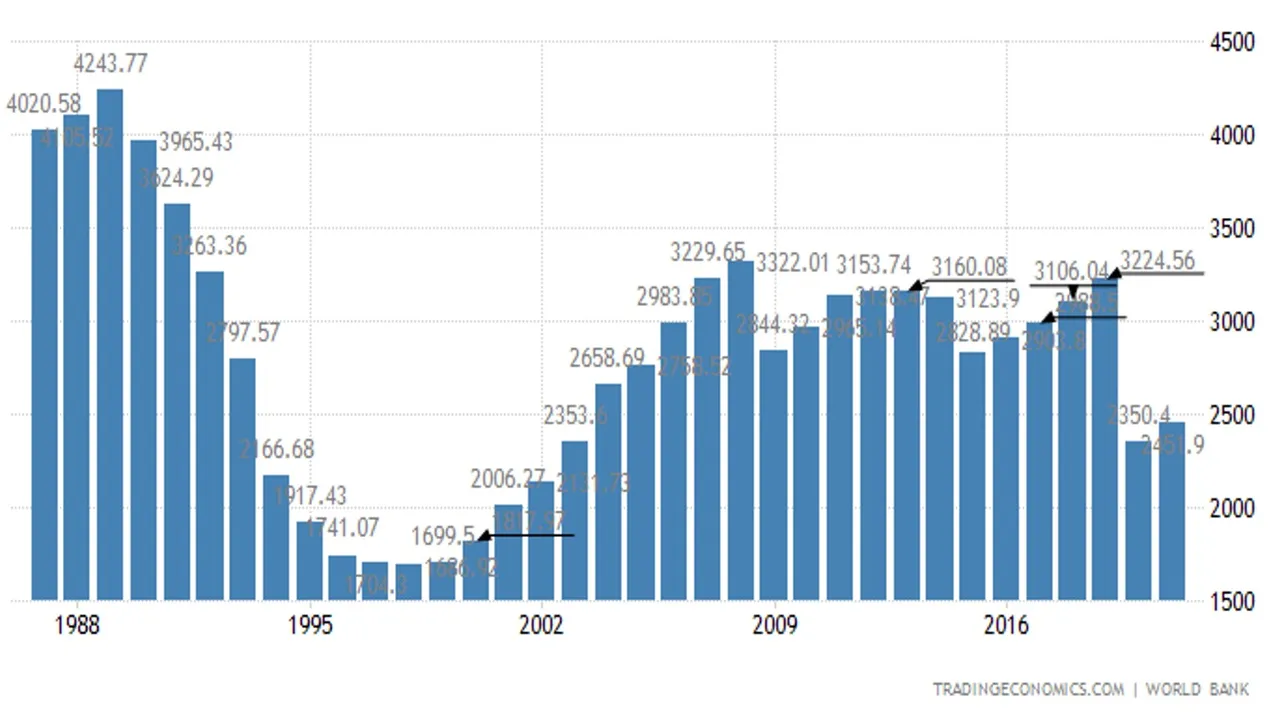
Source: Trading Economics
After the break-up of the Soviet Union in the late 1980s, Ukraine’s GDP per capita plunged dramatically in the 1990’s before starting to recover in the 2000’s until the financial crisis around 2008 to 2010. GDP per capita stagnated for about a decade before falling in 2020 and 2021. Ukraine’s GDP per capita has yet to return to where it was during the Soviet era.
According to Economist Intelligence (EIU), based on 2021 indices relating to level of democracy, Ukraine is considered a hybrid regime (see below). Ukraine scored particularly badly in terms of functioning Government with a score of 2.36 out of 10.
Hybrid regimes: States that hold elections that are not necessarily free and fair. There may be widespread corruption and weak rule of law, with problems regarding government functioning, political culture and political participation. The media and the judiciary are likely to be under government influence (IEP Global Peace Index 2022).
Transparency International is a global movement that focuses on corruption. They measure corruption in countries around the world. They have developed a Corruption Perception Index. According to this Index, in 2021, Ukraine obtained a score of 32/100, which ranked them 122 out of 180 countries. Based on this index, Ukraine is the second most corrupt country in Europe behind Russia.
According to a 2021 nationwide survey conducted by the Kyiv International Institute of Sociology (KIIS), the level of public trust in the Ukrainian Government and politicians is low. Of the 2,000 people surveyed, 27% trusted and 50% distrusted their president, 14% trusted and 60% distrusted their Government, and 11% trusted and 67% distrusted their parliament.
Puppet President
It is unlikely that Ukrainian President Zelensky has any significant power or authority in Ukraine. He is likely to be subservient to Ukranian oligarchs such as Ihor Kolomoyskyi and the US Government. Ihor Kolomoyskyi is a powerful businessman, he controlled one of Ukraine’s biggest banks (PrivatBank) and owned a significant share of the Ukrainian media (e.g. 1 +1 Media). He funded both Zelensky’s acting career as well as his presidential campaign. Without Kolomoyskyi’s influence Zelensky would not have become president (Politico).
Ihor Kolomoyskyi has funded extremist military groups in Ukraine such as Dnipro, Aidar, and Azov battalions to the tune of US$10 million (Wikipedia). Ihor Kolomoyskyi has been linked to multiple crimes such as bribery, money laundering, and contract killings. A large portion of his wealth has been invested in US manufacturing plants and offices in Ohio and Texas (Spectator). In 2022, Ihor Kolomoyskyi was stripped of his Ukrainian citizenship but his connection to Zelensky most likely still exists.
Ihor Kolomoyskyi has had business dealings with Hunter Biden (son of Joe Biden) and Devon Archer (chaired the support committee for the 2004 presidential campaign of John Kerry). In 2014, both Hunter Biden and Devon Archer were appointed to the Board of Directors of Burisma Holdings (owns most of Ukraine’s gas companies), a company controlled by Ihor Kolomoyskyi. The US Government have significant political interest in Ukraine and desire to implement their style of democracy in countries adjoining Russia (Atlantic Council). Ironically, US intervention has done very little to benefit the people of Ukraine as can be seen from the information presented in the previous section.
Civil War from 2014
The military conflicts in Ukraine began long before the Russian military became directly involved in 2022. There has been civil war in Ukraine (Donbass Region) since 2014. The civil war was triggered when pro-Russian President Viktor Yanukovych was forced out of office in early 2014. This ousting was allegedly backed by US and EU Governments (Radio Free Europe Radio Liberty). The new Ukrainian President was not recognised by Russia. The ousting created tensions in South and East Ukraine. This led to the Russian backed Referendum in the Autonomous Republic of Crimea for them to join the Russian Federation. The referendum passed with a majority of 97% (Wikipedia). It is also led to the beginning of the civil war in the Donbass Region.
Ukraine is strongly divided in terms of support for western and Russian values, ideology, culture, etc. North and West are predominantly pro-western and South and East are predominantly pro-Russia. This can be demonstrated clearly using the map for the 2010 presidential election results. See Figure 2.
Figure 2: 2010 Presidential Election Results
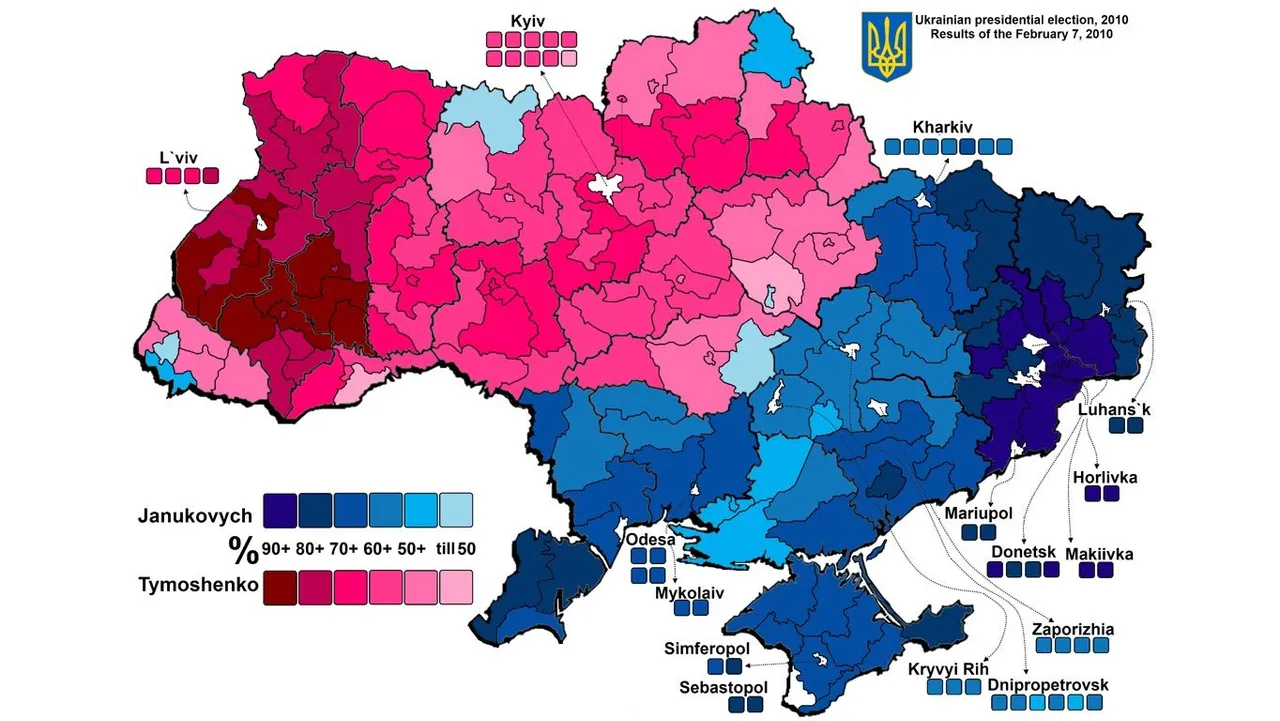
Source: Wikipedia
Note: Yanukovych (pro-Russia) and Tymoshenko (pro-western)
According to the United Nations High Commissioner for Human Rights, between April 2014 and June 2021, between 13,200 and 13,400 people were killed (3,901 civilians) and 29,600 to 33,600 people were wounded (approximately 7,00 to 9,000 civilians) in the Donbas Region (Promote Ukraine). According to more recent data collected by the International Crisis Group, the number of people killed in the Donbass Region exceeds 14,000. The International Crisis Group have published data regarding various aspects of the conflict in Donbass such as casualties, cause of causalities, and shelling. Figure 3 contains data for shelling.
Figure 3: Shelling in Donbass (January 2018 to January 2022)
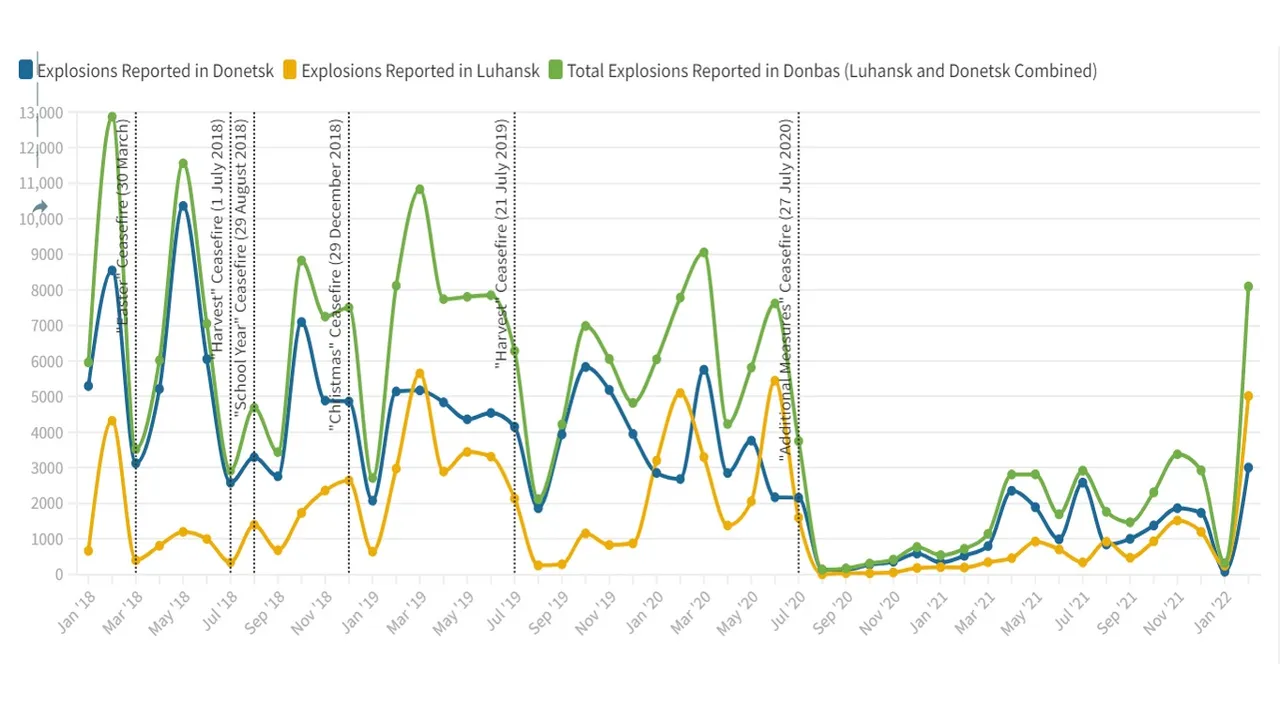
Source: International Crisis Group
Ukrainian politics and military are influenced by far-right nationalist groups such as the Azov movement. Avoz Battalion formed in 2014 as a response to Crimea joining Russia and the rise of the separatist movement in Donbass. In December 2014, the Azov Battalion became incorporated into the Ukrainian National Guard where it became the Azov Regiment. The Avoz Regiment continued to grow with the recruitment of foreign mercenaries. Between 2014 and 2019, around 17,000 foreign mercenaries from 50 countries fought in Ukraine, it is uncertain how many of them fought with the Azov Regiment (Stanford Center for International Security and Cooperation).
As of 2019, the Azov movement had 22,500 followers. This consisted of 20,000 National Corps supporters, 1500 in the Azov Regiment, and 1000 National Militia (Stanford Center for International Security and Cooperation). Some of fighters in these extremist groups have been trained in western countries such as Canada, US, France and the UK (Jerusalem Post).
Members of the Azov Regiment use Nazi symbols such as the Wolsfangel symbol on a black sun and the Totenkopf patch (Nazi SS Skull symbol) on uniforms (Defend Democracy Press). The Azov Regiment has close links with Neo-Nazi groups such as Misanthropic Division, which has mostly merged into the Azov Regiment and the Right Sector who were actively involved in the Euromaidan protests, which led to the overthrowing of President Viktor Yanukovych. There are other radical military groups in Ukraine such as the Aidar Battalion (Wikipedia) and the Dnipro Battalion (Wikipedia), which have allegedly committed war crimes in East Ukraine (Axis of Logic).
This long ongoing conflict in Ukraine and the atrocities committed during that time gained no significant attention in media around the world. The western world, in particular, had no interest in Ukraine or any of the suffering occurring from 2014. Figure 4 contains an analysis of global Google searches for the word 'Ukraine'.
Figure 4: Trends for searches for Ukraine (2004 to 2022)
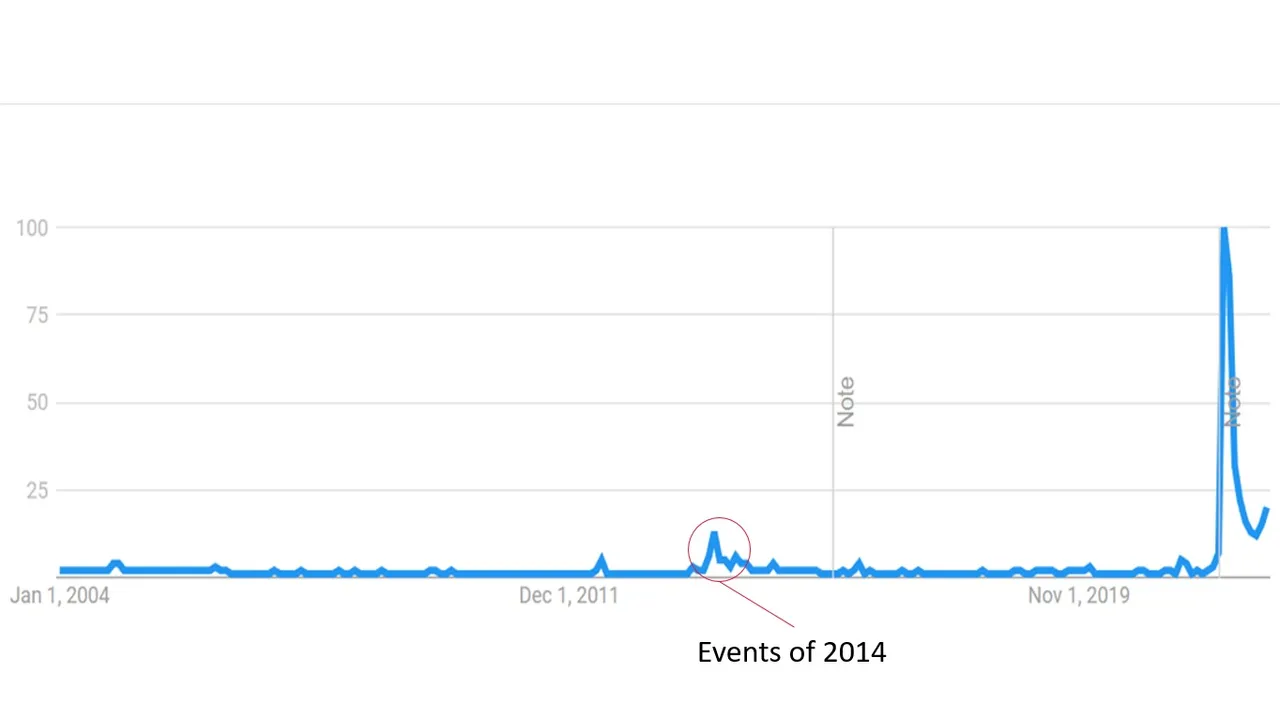
Source: Google Trends
As can be seen from Figure 4, searches for Ukraine on Google increased by an immeasurable amount the week Russia invaded Ukraine and has remained considerably higher than it was prior to the attack. Even at the height of the events in 2014, Google searches were only a small percentage of what they have been since the start of the current war. Public interest has been fuelled by constant media coverage during the first month of the war and regular coverage the months afterwards. Interest spikes when the media want to highlight particular events.
Quick Summary
Ukraine has greatly struggled economically since leaving the Soviet Union. They have struggled politically with corruption and stability. The country is divided between support for pro-Russian and pro-Western ideology. There has been an 8-year civil war between the Ukrainian military and the Russian backed separatist’s movement, this has taken a huge toll on civilian lives and greatly contributed to economic hardship. Ukraine has a strong radical far-right presence that supports Nazi ideology.
The War in 2022
In February 2022, Russia launched what initially looked like the beginning of a full scale invasion of Ukraine. They rapidly occupied a large area of land. They had a large army just North of Kyiv (Capital of Ukraine) and it looked like they might attempt to take the city in the coming weeks. Instead, they just waited and made no attempt to enter Kyiv. It appears that their presence was more of a threat to pressure the Ukrainian Government to negotiate with them and for them to agree to their terms. This could have ended the conflict very quickly with minimal loss of lives on both sides. Some of Russia’s terms from early negotiations were as follows.
- Ukraine will agree to sign a neutrality agreement that would bar it from entering NATO (and EU)
- Ukraine will recognize Crimea as Russian
- Ukraine will recognized the regions of Luhansk and Donetsk as independent
- Ukraine will cease all military action.
Source: News Week
There was also the reoccurring themes of demilitarising and de-Nazifying of Ukraine. These were areas Ukraine were not going to agree on.
In April 2022, Russia and Ukraine tentatively agreed to a peace deal based on the above dot-points (Foreign Affairs). As a claimed show of good faith, Russia withdrew troops that were in close proximity to Kyiv (Republic World). However, the peace deal did not eventuate. UK Prime Minister Boris Johnson visited Ukraine after the talks to tell President Zelensky not to negotiate with Russia (ScheerPost). There was also reports of mass murdering of civilians by Russian troops in Bucha. This essentially put an end to any peace talks.
Even though the chances for successful peace talks were becoming unlikely, the military conflict did not escalate. Russia withdrew some of its military forces from Ukraine. The remaining Russian forces focused on capturing the Donbass Region (Bloomberg). This led to a slowing down of the war. Russia made gradual methodical progress. Russia struggled to capture areas as Ukrainian military were fighting from populated areas. They used residential buildings, schools, and hospitals as bases. This put civilian lives in danger (Amnesty International) and this also contributed to the massive damage done to buildings in populated areas. The biggest breakthrough for Russia was in May when they captured the city of Mariupol (large city in southern Ukraine). This city is the base of the Azov Regiment (Vox). Defeating the Azov Regiment was an important step in de-Nazifying Ukraine.
After the capture of Mariupol, for several months, it appeared little progress was made by either side. Around August, Ukraine launched several offensives to recapture territory taken by Russia. They had considerable success in gaining territory in the North-East near Ukraine’s second largest city Kharkov (CNBC). However, the gains were mostly territory and villages and not major towns or cities. The victories were mostly because Russian military had retreated from these areas rather than through fighting (The National).
In the South, the offensive has had minimal success with just a small portion of land reclaimed. They are aiming to recapture Kherson (large city in southern Ukraine). They are most likely aiming to do so before early November (before US midterms); we should expect an all-out attack from Ukraine before then. Ukraine’s offensives are coming at a heavy cost of life and equipment to their military. According to the BBC, they are losing up to 200 troops a day. Most of these lives are lost because of attacks from Russian heavy artillery, multiple rocket launch systems and aviation.
Also in August, Ukraine attacked the Russian airbase in Crimea reportedly destroying some planes (The Guardian). The extent of damage and means of doing so, varies based on different sources (some say airstrike and others say terrorist attack). In Moscow, Daria Dugina daughter of prominent political philosopher Aleksandr Dugin was killed by a car bomb. According to the New York times, US intelligence agencies believe this terrorist attack was authorised from within the Ukrainian Government
Major Military Escalations
Up until now, for the majority of the war, leaders of western countries have been committed to extending the duration of the war for as long as possible. They have continuously sent weapons to Ukraine, they have provided training to their troops, they have provided intelligence, they have provided military strategic input, they have heavily sanctioned Russia, they have stolen Russian citizen’s assets, they have strongly opposed peace talks, and they have encouraged mercenaries to fight on the side of Ukraine (multiple sources on the internet). According to Politico, NATO are developing a 10-year plan to further militarise Ukraine with western weapons.
Extending the duration of the war may no longer be sufficient. Recent events have increased the likelihood that this war will extend beyond just Ukraine. Below are some of the recent escalations.
- The Nord Stream 1 and 2 pipelines have been sabotaged.
- Russian backed leaders conducted referenda for 4 regions (Luhansk, Donetsk, Zaporizhzhia, and Kherson) to join Russia.
- Russia’s partial military mobilisation of 300,000 troops
- The Kerch Bridge (bridge connecting Crimea to mainland Russia) was damaged by a terrorist attack.
- Russia launched widespread missile and drone attacks on infrastructure in many Ukrainian cities.
The damage to the Nord Stream pipelines cuts gas supplies from Russia to Germany and much of the EU. It hurts both Russia and Germany. Russia have lost a powerful bargaining chip in negotiations and the people of Germany may not have sufficient gas supplies to heat their homes this winter. The USA could greatly benefit, if the damage to the Nord Stream pipelines cannot be repaired. They will have a large new market for their Liquefied Natural Gas (LNG) as well as greater political influence over Europe. Thus, the US are the mostly suspect for this attack but further investigations are still required.
From September 23 to 27, referenda were conducted in the 4 Ukrainian regions of Luhansk, Donetsk, Zaporizhzhia, and Kherson. The results of the referenda strongly indicated that the people of the 4 regions wanted to join Russia. According to Russian media, the results of the referenda were as followers.
- In the Kherson region, 87.05% of those who voted supported joining Russia, voter turnout was 76.86%.
- In the Zaporizhzhya region, 93.11% of voters supported joining Russia, voter turnout was 85.4%.
- In the Donetsk region, 99.23% of voters supported joining Russia, voter turnout was 94.15%.
- In Luhansk region, 98.42% of referendum participants voted to join the Russia, voter turnout was 97.51%.
Considering the referenda were conducted under war time circumstances, it is unlikely that the results would have been accurate. People in some parts of the regions would not have had access to vote. Ukrainian Government made voting in these referenda illegal, voting could be punished with a sentence of up to 5 years in prison (Zero Hedge). Many people who would have voted to remain in the Ukraine would not have voted because of the fear of being arrested or worse. Considering the pro-Russian sentiments in these regions shown by voting patterns in the 2010 President Election (Figure 2) and the civil war from 2014 onwards, the outcomes of the referenda were expected. The results in Kherson region may have been much closer if people had not been afraid to vote.
On 4 October 2022, according to Russian law, the 4 Ukrainian regions of Luhansk, Donetsk, Zaporizhzhia, and Kherson officially become part of the Russian Federation based on the referenda held in the regions (Yahoo News). This move has escalated the conflict as Russia can justify defending these regions with the same force as it would for its existing territories.
Russia have backed up the acquisition of these regions with the partial mobilisation of an estimated 300,000 troops for the claimed purpose of providing military defence to these new Russian regions. An article by the Center for Strategic and International Studies explains the possible impacts this mobilisation will have on the war. The mobilisation has caused panic among many in Russia. Large numbers of people have rushed to the borders to escape the possibility of being called up (BBC). Fear of a general mobilisation has increased significantly from February to September 2022 (Statista).
The referenda did not deter the Ukrainian offensive, they continued to push into the regions with their military gaining territory in the south and capturing Lyman (town in the east). These areas did not appear sufficiently protected by Russian forces who were forced to retreat (Euro News). The recapturing of territory comes at a huge cost for many pro-Russian civilians living in these areas. Ukrainian military have been hunting down and murdering civilians who are suspected of collaborating with Russian forces (Daily Mail).
These incidents may offer some perspective on the killings that were reported to have occurred in Bucha (town just north of Kyiv) in April. Ukrainian authorities claimed Russia forces executed hundreds of civilians in Bucha during their occupation. However, the condition of the bodies found and photographed appeared to show signs they have been killed after the Russian troops had left. The bodies had the white armbands indicating they were neutral or Russian sympathisers (Global Research). The killing of civilians in Bucha appears consistent with what is happening with the capture of eastern towns and villages.
The incorporation of the 4 regions into Russia could have led to de-escalation if it had been followed by peace talks. Instead, Ukraine responded with proposed membership to NATO. I suspect Ukraine’s recent progress on the battlefield contributed to their reluctance to negotiate. They also strongly oppose permanently conceding land to Russia under any circumstances. They are even threatening to attempt to recapture Crimea which joined Russia in 2014. The capture of territory can also be used as an argument that western military assistance has been effective and that it should continue so that Ukraine can fully recapture all land lost.
The weapons that reached the Ukrainian military have helped them resist Russian attacks but the distribution of weapons to Ukraine has not been carefully monitored. It appears many of the weapons sent have not been reaching the Ukrainian soldiers on the frontlines. Some of these weapons are likely to have found their way onto the black market. Ukraine has a history of selling weapons on the black market. Between 2013 and 2015, 300,000 weapons disappeared from Ukraine. Only 13% of these were recovered (Global Research). The powerful weapons sent to the Ukraine could end up in the hands of rebel forces or terrorist groups. This could lead to more violence in Europe.
On 8 October, the Kerch Bridge was damaged by a terrorist attack (NPR). It appeared that a truck travelling across the bridge exploded. The powerful explosion caused a train carrying fuel to catch fire and several carriages exploded. A couple of lanes on the road bridge collapsed and the railway bridge received mostly superficial damage. The railway bridge reopened and the road bridge partially reopened within a day (BBC). The railway bridge has been used to move military vehicles and equipment into Crimea from Russia (Reuters). However, the attack was made to the road, which should be considered as purely civilian infrastructure. People in Kyiv were celebrating the terrorist attack by posing in front of a giant stamp of the bridge exploding (Reddit Post).
A few days after the bridge was attacked, Russia launched airstrikes on almost all of Ukraine’s major cities. According to the Ukrainian Prime Minister, there were 128 airstrikes over just 3 days. They mostly targeted energy and communication infrastructure (TASS). Ukraine officials claimed that 19 people were killed in these airstrikes (VOX). Cities such as Kyiv have not been targeted for several months. The airstrikes can be considered as Russia’s response to the attack on Kerch Bridge.
Little Appetite for Peace
The escalation of war with a nuclear power such as Russia is incredibly dangerous. Despite the potential risks of nuclear war, peace talks are still not considered an acceptable option. Elon Musk, the richest man in the world, offered to help negotiate a peace deal between Russia and Ukraine. He briefly outlined a proposal in a Tweet. He received strong criticism, outrage, and even abuse from Ukrainian officials. See the proposal and some of the responses below.
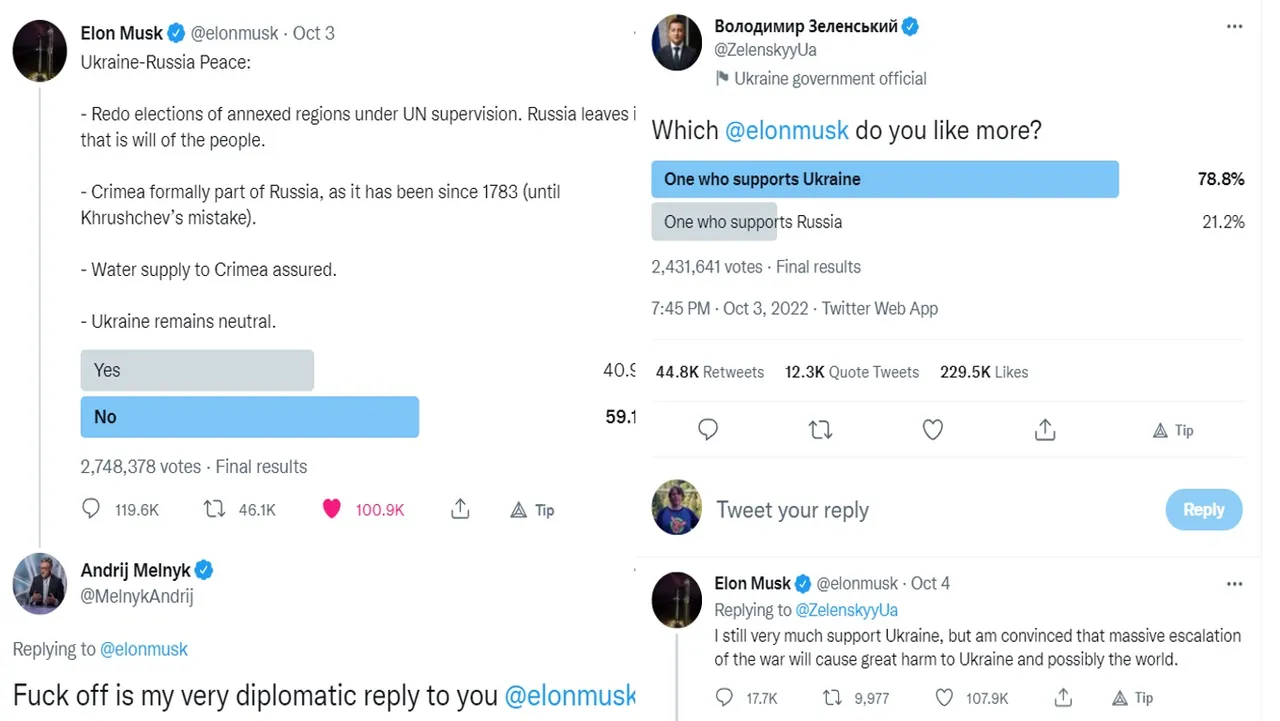
Source: Tweets from Elon Musk and Andrij Melnyk (Ukrainian Diplomat) and Volodymyr Zelensky
Offering peace deals over Twitter is a little ridiculous but the degree of negativity in the responses demonstrates the unwillingness for peace on the Ukrainian side. It is also surprising Elon Musk received such a response since his provision of Starlink has greatly enhanced communication in Ukraine (Express).
President Zelensky has even asked his allies to use pre-emptive strikes against Russia to deter them from use nuclear weapons in a speech made to Lowy Institute in Australia (Lowy Insitutes). A few days later, President Zelensky claimed he actually meant pre-emptive sanctions (Kyiv Independent). Maybe, he has been told to tone down his language.
US President Joe Biden has discussed the possibility of nuclear war/Armageddon on several occasions. He recently discussed the topic in an interview with CNN. There are claims Vladimir Putin threatens to use nuclear weapons. Media reports have discussed Putin’s possible intentions for use of nuclear weapons in the war (Guardian) but have not quoted any statements directly from him verifying that is actually the case.
Several months ago Russian media made reference to the impact of a potential nuclear strike on London (Daily Mail). In February, Russian nuclear forces were placed on high alert (AP News). There have been claims made on Twitter that instructions for nuclear preparedness are being handed out in Russia (Kim Dotcom Twitter). Russia could be preparing for nuclear war or it could be just fearmongering. It is difficult to obtain the same information that the Russian people are receiving because of censorship of Russian media content.
What is public opinion?
It is difficult to gauge public opinion. Based on the responses by Western Governments, mainstream media, social media posts and even the Eurovision song contest voting; it would appear the western public opinion and even that of much of the world was behind Ukraine. However, Government action often does not represent the views of the people and neither does the mainstream media. Social media could be a better representation of what people think. According to the Daily Sceptic, at the start of the war, 90% of English Language Tweets were in favour of Ukraine as can be seen in Figure 5.
Figure 5: Tweets in favour of Ukraine or Russia
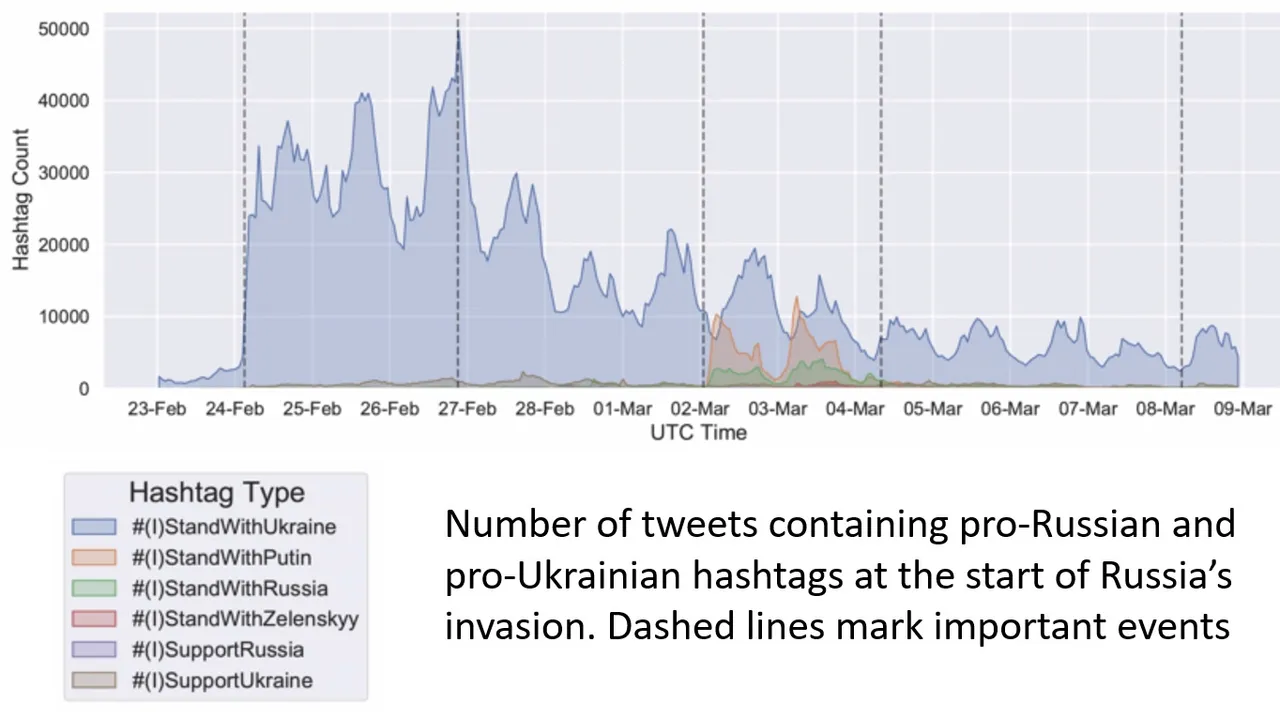
Source: Bridget Smart et al
However, algorithms manipulate what appears as popular opinion and bots can artificially inflate the number of posts of a particular view. The study was only conducted for the first month of the war. It does not indicate how views may have changed as the war progressed. It appears support for Ukraine is falling. According to a poll conducted on Twitter by French TV Station Sub Radio, 87% of respondents opposed continued support for Ukraine in the war with Russia (The News on Time). This is only a small sample of people who follow a particular broadcast. It may not be representative of western public opinion in general.
Based on my personal experience, I would say the support for Ukraine at the start of war was very strong. On the street where I live, several houses put up the yellow and blue of the Ukrainian flag. Many people I know on social media put little Ukrainian flags in their profiles. Several of the top posts on Hive were from Ukrainian people describing their experiences from the early days of the war. People supported Ukraine because the first few days of the war were horrendous and looked completely unprovoked. The lives of most Ukrainian people were completely shaken and for many their lives were changed forever. Russia’s invasion did this to these people. People supported Ukraine because that was the compassionate thing to do. It is far more difficult to sympathise with the aggressor.
People also showed support for Ukraine quickly because of distrust and dislike of the Russian Federation and Vladimir Putin. In the west, Russia have been consistently villainised for decades. This is done in the news media with allegations of election fraud (domestic and international), suppression of opposition parties/leaders, embezzlement, espionage, assassinations, suppression of freedom of expression, war crimes, mafia killings, and the list goes on. If Russia is suspected of any wrongdoing, it is going to be discussed by the western mainstream media. Few other countries are treated the same way. Western movies have portrayed Russians as being villains for generations. The idea of Russians being the villains is ingrained in many people. Therefore, when Russian does something as aggressive as bombing and storming into another country, people will almost unquestionably see Russia as the villain and whoever they may have attacked as the victim.
Beyond the western world, the perception of Russia could be very different. We do not know how the national media of their countries portray Russia. Western media is powerful and reaches most countries around the world but their influence will vary from country to country. It is also important to acknowledge that western presence, practices and cultures are not universally admired or desired. Western countries impose themselves on the world far more than Russia. The US have at least 600 overseas military bases (Wikipedia) compared to Russia’s 20 plus overseas military bases (Wikipedia). The US has an almost endless list of countries they have intervened with economically, politically or militarily. Therefore, people from non-western countries are likely to be more open to understanding the Russian Government’s intentions in intervening militarily in another country.
The majority of Russian citizens are firmly behind President Putin and his invasion of Ukraine (referred to as special military operation in Russia). Since the start of the invasion, President Putin’s approval rating has increased from 71% to over 80% and was 77% in September and according to TASS his approval rating exceeded 80% again in October. See Figure 6 for Vladimir Putin’s approval ratings since 1999.
Figure 6: Vladimir Putin’s Approval Rating
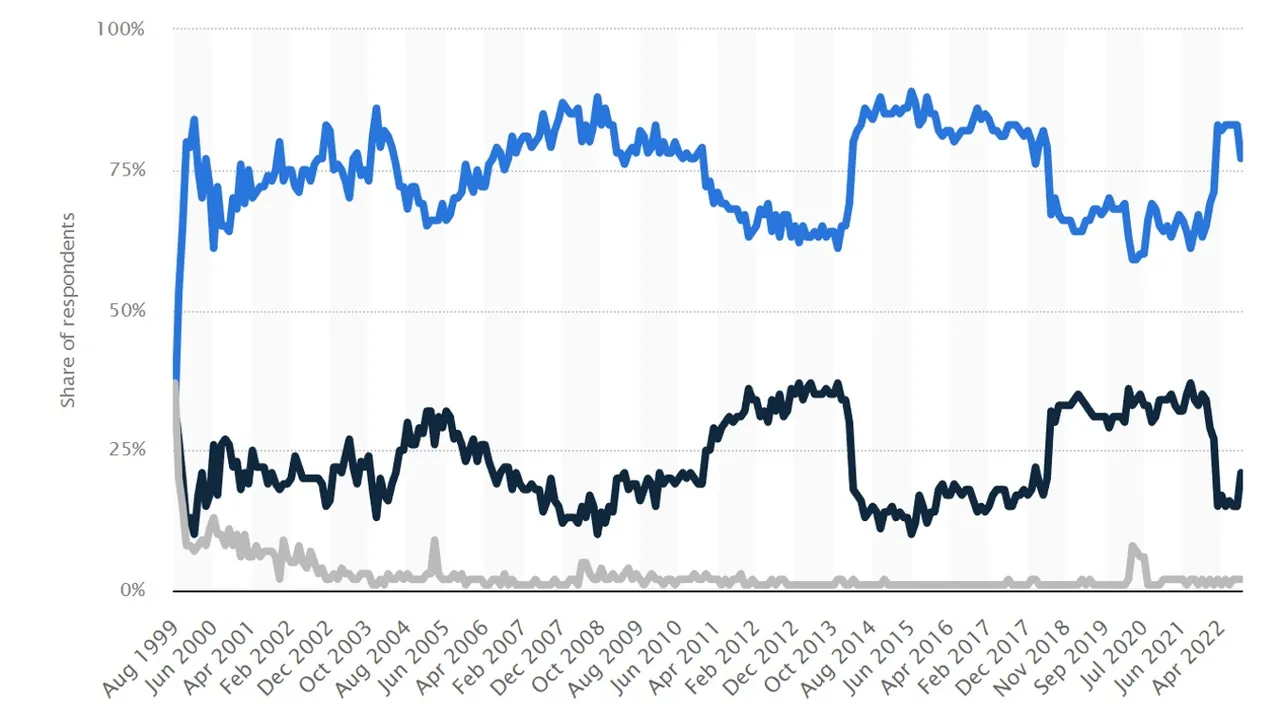
Source: Statista
Note: Light blue represents approve, dark blue represents disapprove, and grey represents don't know.
The use of the terminology special military operation creates the impression that Russia was only intervening along defensive lines for the people in the Donbass Region rather than an attempt to capture or destroy large portions of Ukraine. The eventual scale down of military operations became more consistent with this message. Over time, I imagine most people would have understood that Russia’s military action resembled more of an invasion than a special military operation. The mobilisation of more troops clearly demonstrates preparedness for a larger scale war. Despite the realisation that Russia is involved in a significant military conflict, Vladimir Putin’s approval rating has remained high. The small percentage of people that do oppose him, do so quite fiercely and 20% of 150 million (population of Russia) is a significant number of people.
Will we have World War 3?
Despite, the escalation of the war, unwillingness to negotiate peace, and reckless talk about nuclear armageddon; I believe nuclear war is unlikely. Russia have shown no desire to initiate a nuclear attack. For the most part, they have approached the war with caution. Most key civilian infrastructure beyond the eastern and southern parts of Ukraine have been left intact. They have not damaged any of the nuclear power plants within Ukraine. If they wanted nuclear war, they would have targeted them. Western countries have no intention to initiate a nuclear attack. Joe Biden’s babbling could be cause for concern but he is the president in name only. He lacks cognitive ability to perform simple tasks and he demonstrates this on at least a weekly basis. Joe Biden’s handlers desire the benefits of a long proxy war with Russia because it is profitable for them as well as another mechanism for controlling people.
I believe a non-nuclear version of World War 3 is possible. Tensions extend beyond just Russia and Ukraine. Neighbouring countries such as Belarus could become involved on Russia’s side (Euractiv). There is potential for escalation between Russia and Poland or other countries close to the conflict. I do not believe the Russian military will advance too far beyond its borders in Europe. The Russian military has been structured for the purpose of defending Russian territory and not for the purpose of a large scale invasion. They have a limit to the number of conscripts that can be deployed outside of Russia (Center for Strategic and International Studies). However, it is possible military war could break out on several other different fronts considering the non-military war has become global.
Tensions between the west and China has been increasing. UK have or are planning to declare China a threat (Guardian). There are increased tensions with the US regarding Taiwan. There are increasing tensions between the US and Saudi Arabia regarding reduced oil production (Bloomberg). Tension has grown between Serbia and Kosovo. NATO consider it serious enough to consider sending troops into Kosovo (Reuters). Serbia are not sanctioning Russia and could be considered pro-Russian by western countries. Any of the countries not condemning Russia or have offered support could become targets for potential escalation by western countries.
If the war does not escalate into a world war, there is a good chance the war will be prolonged. This is because both sides intended it to be from the start. As explained earlier, Western countries have clearly shown their intent to extend the war. However, it could also be the intentions of Russia as well.
We could argue that Russia was goaded into this war by the US. The allegedly leaked RAND document discusses how to create war in the Ukraine and force Russia and the EU to oppose each other for the benefit of the US (see my post Winners and Losers from the “Cost of Living Crisis” for explanation). The arguments are logical from the US’s point of view but not necessarily sufficient for Russia to respond in the way they did. Russia could have taken military action years earlier and arguably had more cause to do so when the fighting in the Donbass Region was most intense and more civilian lives were lost. The spike in attacks on the Donbass Region just prior to their invasion was still less aggressive than previous years; see Figure 3. The west have implied Ukraine could become a NATO member (Guardian). However, they have made no steps to formally include them. It should be obvious to Vladimir Putin that Ukraine joining NATO is unrealistic. Hence, the timing of the war is likely to be for reasons not openly disclosed by Vladimir Putin.
The early rapid advance on Kyiv as a threat to force Volodymyr Zelensky to concede to Vladimir Putin's demands was unlikely to succeed. Putin should have know that Zelensky is unlikely to be able to or be allowed to agree to a peace deal by himself (see discussion about failed peace deals made earlier in the post). Negations need to be directed towards the people that hold the real power. According to Victor Orban (Prime Minister of Hungary), peace negotiations need to be between the US and Russia (Euro Weekly News). Unfortunately, Joe Biden is incapable of doing this and nobody else in Government is in the position to negotiate. A leader like Donald Trump, who has been on a much longer leash could successfully negotiate a peace deal with Putin. Earliest Trump could become president is early 2025. If this is how the war ends, we have a long way to go.
We could argue that the severe sanctions placed on Russia will cause their economy to collapse thus making this war impossible to fund over a prolonged period. This would be the case if the sanctions were causing Russia the most economic problems. However, it seems the sanctions are causing the countries imposing the sanctions more problems than Russia. According to Goldman Sachs, Russia’s economic activity is recovering while the largest economies in Europe are heading towards recession. See Figure 7. The Russian Ruble has also performed well against the US dollar since the initial shock at the beginning of the war (Yahoo Finance). It looks like they will be able to sustain their war efforts in the long-run.
Figure 7: Goldman Sachs Activity Indicator
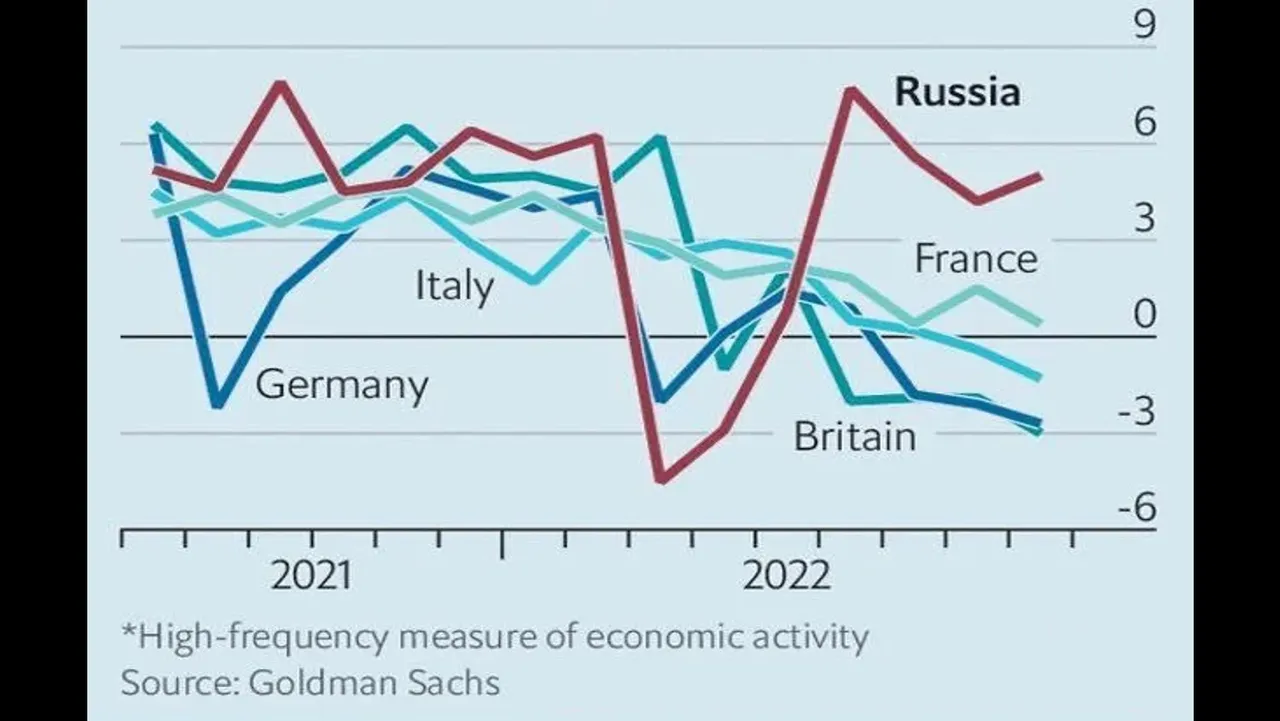
Source: Goldman Sachs cited by the Economist
Many people would like to believe Vladimir Putin is ant-Establishment. The western Governments are trying to remove him because he is a threat to the Establishment. These people are overlooking the reality that he has been complicit to many aspects of the global agenda. He strongly supported the Covid-19 vaccine rollout, Digital IDs, and Central Bank Digital Currencies (CBDC) (Edward Slavsquat). Klaus Schwab (founder and executive chairman of the World Economic Forum (WEF)) identifies Vladimir Putin as a WEF global leader (Financial Post). The timing of the invasion occurred very conveniently directly after the Covid-19 fiasco had run its course. It fitted like it was the next step in the social and economic destruction of the world.
My Final Assessment
I think the chances of World War 3 have increased substantially since the start of the war but I think it is still unlikely and I think a world destroying nuclear war is even less likely; a false flag tactical nuclear attack or even the use of chemical weapons is more likely. I believe the most likely scenario is a prolonged war in Ukraine, which may spill over to other countries but will stop short of a military war of a scale to be considered a world war. Prolonged war appears more aligned with the interests of the people fuelling the war. The threat of world war is and can be used as very effective fearmongering tool to control people. It keeps people divided. It enables the economic and social collapse of most European countries and even the USA. It facilitates the centralisation of power.
For a more detail explanation of the likely winners from the Ukraine war, read my post Russia-Ukraine War 2022: Winners and Losers (Part Two: Winners). I would also recommend that you read my post Russia Invades Ukraine: What is going on? where I discuss the possible motives of this war from both sides. As I have become more informed my views regarding the war have changed a little.
Struggle for Information
If you are living in the UK or the EU, the versions of events you are exposed to are strongly biased in favour of Ukraine. This is because Governments need the public support so that they can keep supporting and prolonging this war. If you want access to alternative media sources of information, I suggest that you use Odysee. There are several interesting commentators on that platform such as:
- New Atlas
- iEarlGray
- Patrick Lancaster (on the ground reporter)
- The Duran
- George Galloway
- Garland Nixon
- Ron Paul Liberty Report
The above channels sometimes conduct interviews or feature interviews with military experts such as Scott Ritter (former UN Weapons Inspector) and Douglas Macgregor (retired US Army Colonel). These military experts focus on their observations regarding the military action rather than supporting a western narrative.
Odysee has the RT Channel, which is banned in the UK. It is a different version than was available in the UK, which was RT International. Their coverage is pro-Russian but they still have some interesting stories that offer information and perspectives not available in western media.
There are still a few users on Twitter who share interesting links. For example award winning journalist John Pilger regularly shares articles that offer a more balanced analysis of the war and politics around it. John Pilger has made many documentaries over his long career. His 2016 film titled 'The Coming War on China' should still be available on Netflix and is relevant to the war in Ukraine.
More posts

If you want to read any of my other posts, you can click on the links below. These links will lead you to posts containing my collection of works. These 'Collection of Works' posts have been updated to contain links to the Hive versions of my posts.
Hive: Future of Social Media
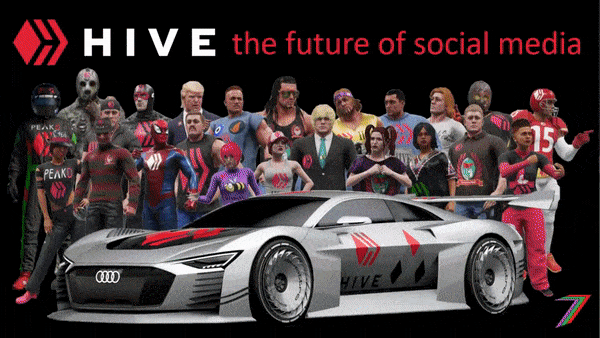
Spectrumecons on the Hive blockchain





